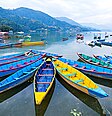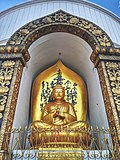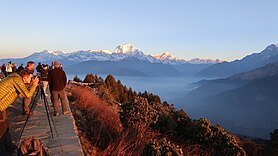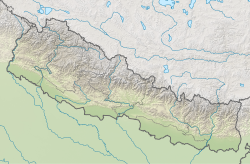Pokhara
पोखरा | |
|---|---|
Annapurna mountain reflected in Phewa lake Boats in Baidam | |
| Nickname(s): City of lakes , Tourism Capital of Nepal | |
| Motto(s): | |
 | |
| Coordinates: 28°12′30″N 83°59′20″E / 28.20833°N 83.98889°E | |
| Country | |
| Province | Gandaki |
| District | Kaski |
| Incorporated | 1962 |
| No. of Wards | 33 |
| Government | |
| • Type | Mayor-council |
| • Body | Pokhara Metropolitan City Council |
| • Mayor | Dhana Raj Acharya, CPN (Unified Socialist)[1] |
| • Deputy mayor | Manju Devi Gurung, CPN(UML)[2] |
| Area | |
| • Total | 464.24 km2 (179.24 sq mi) |
| • Water | 4.4 km2 (1.7 sq mi) |
| • Rank | 1st |
| Elevation | 822 m (2,697 ft) |
| Population | |
| • Total | 599,504 |
| • Rank | 2nd |
| • Density | 1,300/km2 (3,300/sq mi) |
| • Households | 120,594 (2nd most) |
| Demonym | Pokhareli |
| Languages | |
| • Official | Nepali and (Other Language) |
| Ethnicities | |
| • Ethnicities | Bahun, Gurung, Chhetri, Magar, Newar, |
| Time zone | UTC+5:45 (NST) |
| Postal Codes | 33700 (WRPD), 33702, 33704, 33706, 33708, 33713 |
| Area code | 061 |
| Website | pokharamun |
Pokhara (Nepali: पोखरा [ˈpokʰʌɾa]) is a metropolitan city located in central Nepal, which serves as the capital of Gandaki Province and is declared as the tourism capital of Nepal.[4] It is the second most populous city of the nation after Kathmandu, with 599,504 inhabitants living in 120,594 households as of 2021.[3] It is the country's largest metropolitan city in terms of area. The city also serves as the headquarters of Kaski District.[5] Pokhara is located 200 kilometres (120 miles) west of the capital, Kathmandu. The city is on the shore of Phewa Lake, and sits at an average elevation of approximately 822 m above sea level.[6] The Annapurna Range, with three out of the ten highest peaks in the world—Dhaulagiri, Annapurna I and Manaslu—is within 15–35 mi (24–56 km) aerial range from the valley.[7][8]
In 2024, Pokhara was declared as the tourism capital of Nepal,[9][10][11] being a base for trekkers undertaking the Annapurna Circuit through the Annapurna Conservation Area region[12] of the Annapurna ranges in the Himalayas. The city is also home to many of the elite Gurkha soldiers, soldiers native to South Asia of Nepalese nationality recruited for the British Army, Nepalese Army, Indian Army, Gurkha Contingent Singapore, Gurkha Reserve Unit Brunei, UN peacekeeping forces and in war zones around the world.[13]
- ^ "Dhanraj Acharya elected mayor of Pokhara". Kathmandu Post. 25 May 2022. Archived from the original on 22 September 2022. Retrieved 28 August 2022.
- ^ "Dhanraj Acharya elected mayor of Pokhara". Kathmandu Post. 25 May 2022. Archived from the original on 22 September 2022. Retrieved 28 August 2022.
- ^ a b "Archived copy" (PDF). cbs.gov.np. Archived from the original (PDF) on 6 February 2022. Retrieved 22 February 2022.
{{cite web}}: CS1 maint: archived copy as title (link) - ^ "Pokhara Lekhnath becomes largest metropolitan city". The Kathmandu Post. 13 March 2017. Archived from the original on 11 November 2020. Retrieved 7 May 2020.
- ^ "कास्की जिल्ला : एक सम्पूर्ण परिचय". Lokpati.com. 24 November 2019. Archived from the original on 6 March 2022. Retrieved 6 March 2022.
- ^ "VNPK—Pokhara Airport | SkyVector". skyvector.com. Archived from the original on 23 July 2021. Retrieved 7 March 2021.
- ^ United Nations Field Coordination Office (UNFCO) (7 June 2011). "An Overview of the Western Development Region of Nepal" (PDF). Bharatpur, Nepal: United Nations: Nepal Information Platform. pp. 1–9. Archived (PDF) from the original on 23 November 2016. Retrieved 22 April 2012.
- ^ Pradhan, Pushkar Kumar (1982). "A Study of Traffic Flow on Siddartha and Prithvi Highway". The Himalayan Review. 14: 38–51. Archived from the original on 23 October 2013.
- ^ "Pokhara officially Nepal's tourism capital now; to remain accessible 24 hours". The Times of India. Archived from the original on 20 March 2024. Retrieved 20 March 2024.
- ^ "Nepal Declares Pokhara as Its Tourism Capital". 19 March 2024. Archived from the original on 20 March 2024. Retrieved 20 March 2024.
- ^ Nepal, S. K.; Kohler, T.; Banzhaf, B. R. (2002). Great Himalaya: tourism and the dynamics of change in Nepal. Zürich, Switzerland: Swiss Foundation for Alpine Research. ISBN 978-3-85515-106-6.
- ^ Holden, Andrew; Sparrowhawk, John (2002). "Understanding the motivations of ecotourists: the case of trekkers in Annapurna, Nepal". International Journal of Tourism Research. 4 (6): 435–446. doi:10.1002/jtr.402. ISSN 1522-1970.
- ^ Gray, Denis (7 July 2016). "Nepal's legendary Gurkhas face an uncertain future". Nikkei. Archived from the original on 11 January 2019. Retrieved 11 January 2019.











